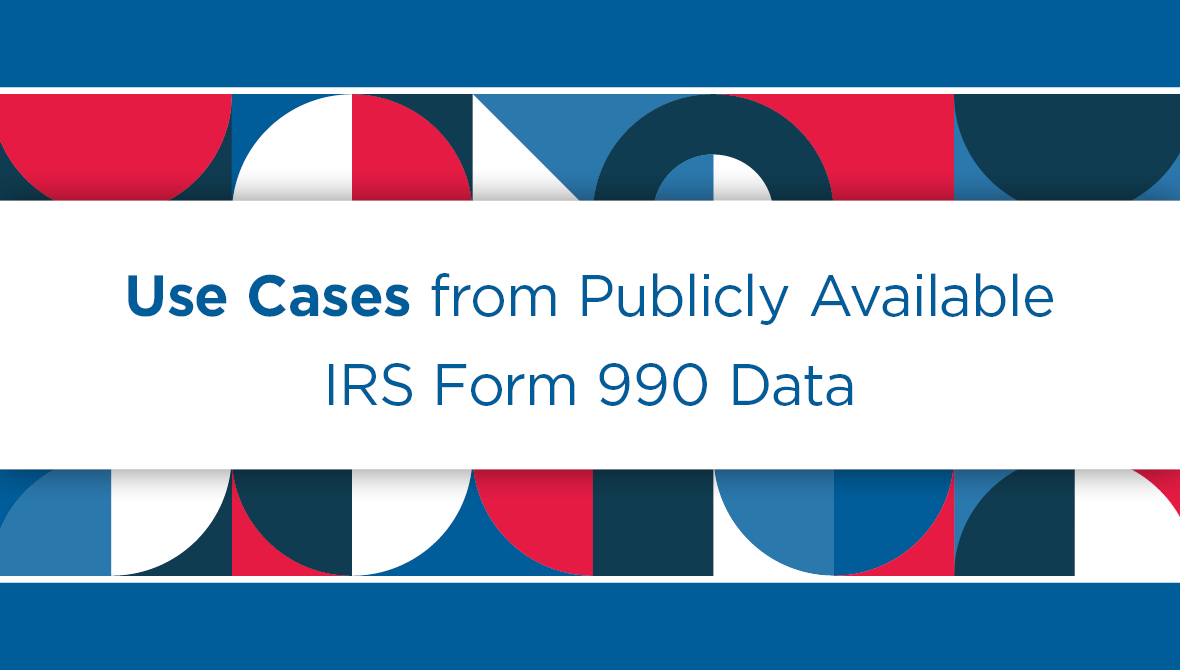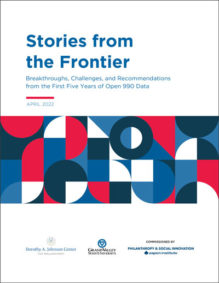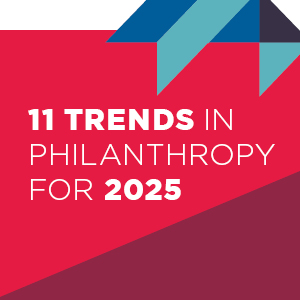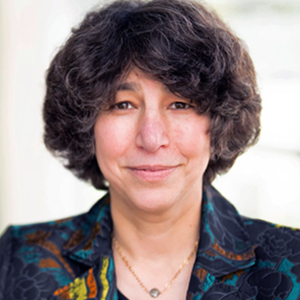Use Cases from Publicly Available IRS Form 990 Data

Open data projects have been in existence for decades, especially as the amount of data stored on computers throughout the world has skyrocketed. Accessibility to that data is at the heart of these efforts, as public and private entities work to make data freely available and useful to the public. Also critical is the role that freely available data in general — and public or government data in particular — play in accountability and transparency in government, as well as increasing both public participation and public awareness.
 The Open 990 Project of the Aspen Institute and its partners represents a giant leap forward, providing nonprofits a connected, data-informed future. The Dorothy A. Johnson Center for Philanthropy at Grand Valley State University, in partnership with the Philanthropy & Social Innovation team at The Aspen Institute, released a report in April 2022 that documented the first five years of the Open 990 Project. The full report, Stories From the Frontier: Breakthroughs, Challenges, and Recommendations from the First Five Years of Open 990 Data, includes:
The Open 990 Project of the Aspen Institute and its partners represents a giant leap forward, providing nonprofits a connected, data-informed future. The Dorothy A. Johnson Center for Philanthropy at Grand Valley State University, in partnership with the Philanthropy & Social Innovation team at The Aspen Institute, released a report in April 2022 that documented the first five years of the Open 990 Project. The full report, Stories From the Frontier: Breakthroughs, Challenges, and Recommendations from the First Five Years of Open 990 Data, includes:
- a history of the Open 990 Project and what it has meant to the field of nonprofit studies,
- a review of structural considerations for open data projects,
- inspirational and cautionary tales from other open data projects, and
- recommendations for ensuring a vibrant and collaborative future for the Open 990 Project.
As a companion to that report, the project team is pleased to present a selected list of how a large number of websites, projects, researchers, governments, and companies are using Open 990 data from IRS Forms 990, 990-EZ, and 990-PF for a variety of public interest projects. After only five years, there are compelling examples available from individuals, nonprofits, and collaboratives alike of how the Open 990 Project is seeding and empowering change throughout the nonprofit sector.
We have grouped the example use cases below by primary audience, and welcome additional suggestions. The project team will be updating this resource list each month throughout 2022.
Jump to section:
- Donors
- Nonprofits & Foundations
- Regulators
- Journalists
- Policymakers & Nonprofit Support Organizations
- Researchers
Donors
- BCT Partners created CUSP, a free tool that helps nonprofits and donors “find and evaluate the capacity of nonprofit direct service providers closest to the communities in greatest need, particularly those most directly affected by COVID-19.” The platform merges information from IRS Form 990s, the American Community Survey, and proprietary geospatial data.
- Pinkaloo used IRS data and other publicly available data on all U.S. nonprofits to create a website that helps banks, employers, community foundations, individual donors, and their networks incorporate giving into their products and services. Users can validate entities as active and official nonprofits and charities, search for nonprofit efficacy and case studies, and search for potential funders.
- Vanguard Charitable designed the Nonprofit Aid Visualizer, a data display platform to help donors search for nonprofits to support during the COVID-19 pandemic’s health and economic crises. Using data from the COVID-19 Community Vulnerability Index, Candid’s information on COVID-19 grants and nonprofits, and John Hopkins Coronavirus Resource Center, the data display aims to increase informed giving decisions while highlighting divides in vulnerability.
Nonprofits & Foundations
- Shena Ashley and Claire Boyd (2021) of the Urban Institute pointed to the need for improved data collection and sharing with respect to racial justice and inclusion in their article, “Addressing Racial Funding Gaps in the Nonprofit Sector Requires New Data Approaches.” They highlighted the Racial Equity Analytics Lab’s efforts to construct a database of arts organizations of color as one example of progress, built from a combination of NCCS and Open 990 data sets.
- The GivingTuesday Data Commons is an outgrowth of the GivingTuesday donation collective, the largest philanthropic data collaboration ever built which includes over 70 partners and 50 data labs. The Data Commons is where the initiative publishes aggregate data, reports, and commentary on donor and fundraising trends flowing from a combination of sources, such as payment processors, giving platforms, Open 990 data, and social media. The collection allows GivingTuesday and its nonprofit partners to analyze donor trends, campaign and messaging effectiveness, and social media engagement in a unified data framework.
- Charity Navigator launched Encompass Rating System, an expanded tool to provide donors with a comprehensive rating system for more than 170,000 nonprofits — growing to more than 18 times its initial number of nonprofits evaluated. They harnessed Open 990 data to evolve their rating system from a four-star rating to a system with more detailed information on impact in a variety of areas, including Finance and Accountability and Leadership and Adaptability.
- OpenSecrets, a nonpartisan and independent research nonprofit, has created Nonprofit Data Search, a search tool aimed at tracking political activities, financial records, and networks of nonprofits to increase transparency. This is part of their efforts to track finances in U.S. politics and their effect on elections and the public policy process. The records in the database can be searched and downloaded for details about grants, board members and financial relationships, staff and vendors, and political spending, as well as other relevant financial details.
- Researchers at the Johnson Center for Philanthropy at Grand Valley State University used Open 990 data to examine investment returns and payout rates of private and community foundations across the nation. They analyzed the usefulness and/or appropriateness of the 5% mandated private foundation payout.
- Researchers from The Aspen Institute, Indiana University, and Hobart and William Smith Colleges analyzed the prevalence of public faith-based foundations. Using e-filed data from 2015 paired with the IRS Business Master File, they undertook the first-ever estimate of public faith-based foundations and studied the scale of their impact through giving.
- Researchers at the Institute of Policy Studies analyzed the average giving of private foundations to commercial donor-advised funds from 2016 to 2018. By reviewing over 81,000 e-filer data files, they identified almost 1,500 that had given to a commercial donor-advised fund in that period and found that private foundation giving to donor-advised funds is sizable. They provided lists of the top ten commercial donor-advised fund recipients, the top ten donor-advised giving foundations, and the top 45 largest commercial DAF sponsors.
- Using Candid’s annual survey of community foundations, researchers at the Institute of Policy Studies examined more than 200 of the largest electronically-filing community foundations in 2019. They analyzed the proportion of foundation assets that was made up of donor-advised funds, as well as the proportions of incoming contributions through donor-advised funds and outgoing grants through donor-advised funds.
Regulators
- The National Association of State Charities Officials documented how regulators used 990 data in a letter to the House Ways and Means Oversight Subcommittee in 2018. As noted in the letter, mandatory electronic filing of IRS 990 forms can significantly enhance the oversight, investigation, and prosecution of fraudulent charities. The 2018 letter called out work by the Michigan Attorney General’s Office, which used searchable 990 data to more quickly take action against a dozen organizations involved in deceptive fundraising.
- The New York Attorney General’s Office provided over $640,000 to breast cancer organizations after recovering the funds from four nonprofits engaged in fraud. Open 990 data helped the office identify the perpetrators, as part of an anti-fraud campaign that has recovered approximately $1.7 million from sham charities and redistributed the funds.
Journalists
- A reporter at the Jewish Telegraphic Agency examined tax returns filed by the multi-billion-dollar Koum Family Foundation from 2015 to 2020. A review of IRS records collected by The Accountability Project, a search tool that includes 990 data and more than 1.5 billion public records, detailed millions of dollars in donations to a religious organization exempt from filing its mission or activity. Further analyzing the foundation’s donations to Jewish charities working in the United States, Eastern Europe, and Israel, the reporter investigated the outsized influence of one of the largest donors to Jewish causes in the world and the role of transparency in funding.
- Journalists for Kaiser Health News investigated to what extent 501(c) tax-exempt hospitals complied with IRS mandates and fulfilled their nonprofit obligations to provide free and discounted medical ‘charity care’ for eligible patients. Analyzing 990 data reported by over 2,500 hospitals to the IRS, reporters found a high rate of nonprofit hospitals that attempted to collect medical debt from low-income patients — who they knew were likely eligible for charity care.
- A journalist with The Boston Globe Spotlight team identified nonprofits in Massachusetts that had reported some type of fraud or embezzlement to the IRS. Analyzing over 2.3 million records from 2011 through 2017, he found more than 1,100 nonprofits nationally had reported a case of embezzlement — but often had not been reported by the press or gone through litigation.
- Journalists at Seven Days created the Vermont Nonprofit Navigator, a search tool for the state’s over 6,000 nonprofits and used the search tool to write a series on Vermont’s nonprofit sector. The search tool holds data up to 2019, and the series reports on a variety of topics, ranging from nonprofit lobbying to “how a Vermont fly-fishing museum’s lawsuit changed the definition of a nonprofit.”
- A journalist for the Chronicle of Philanthropy investigated charitable funding for nonprofits designated as hate groups by the Southern Poverty Law Center. Analyzing 990 data from a seven-year period, he found over 350 donor organizations, highlighted the top nine donor organizations that donated the most money (at least $1 million dollars), which hate group-designated nonprofit organizations they donated to, and the large role played by donor-advised funds as vehicles for giving to designated hate groups.
Policymakers & Nonprofit Support Organizations
- The National Committee for Responsive Philanthropy analyzed IRS 990 data from 2015 to 2019 and found that organizations with anti-abortion crisis pregnancy center programs across the United States received $278 million in foundation funding, compared to $56 million received by frontline abortion clinics and funds. They also found that 1,291 unique organizations that provided crisis pregnancy services received over $4 billion in revenue over this four-year period, with more than half going to 10 larger institutions where services are one of many programs.
- Princeton University’s Eviction Lab collects and shares the kind of data that nonprofits and their business and government sector partners can use to target community solutions, move resources in times of emergency, and track trends over time. Overlaying this information with the geographic landscape of nonprofits in the area can reveal whether, how, and if different neighborhoods are being served by nonprofits and whether those nonprofits have the resources they need to meet demand.
- Researchers at the Johnson Center for Philanthropy at Grand Valley State University used publicly available Paycheck Protection Program loan data, in combination with statistics of the universe of nonprofits from the Open 990 and other IRS data, to estimate the share of nonprofits in each state that received PPP loans. This information was used by policymakers and nonprofit support organizations to review the depth and breadth of nonprofit support during the earliest period of the COVID-19 pandemic economic response.
- Researchers at Arizona State University and Samford University created an algorithm that links individual federal award records from the Federal Assistance Award Data System (FAADS) to recipient Form 990 financial data. This process helps mitigate structural limitations in the data and encourages new research on government awards to nonprofits.
- Researchers from the Nonprofit Institute at the University of San Diego and the California Association of Nonprofits conducted an economic impact study of the state of California’s nonprofit sector. They analyzed the size and economic activities of over 110,000 nonprofit organizations in the state.
Researchers
Finances, Fundraising, and Volunteers
- Researchers at the University of Kentucky and the University of New Mexico studied the role of process accountability in the relationship between government grants and nonprofit financial effectiveness. Using IRS 990 data from 2013 to 2017, they uncovered how government grants had affected nonprofit financial efficacy and suggested that an overemphasis on process accountability may negatively impact the benefits of support toward nonprofit service provision and financial effectiveness.
- Researchers at Northeastern University analyzed $36 billion in U.S. philanthropic giving from over 46,600 foundations to over 48,700 arts organizations in terms of geographical proximity, donor retention, and institutional prestige. Using a decade of 990 data from 2010 to 2019, their findings indicate that support for the arts was locally focused, maintained high donor retention, and had a strong focus on institutional prestige.
- Drawing on IRS 990 e-filer data from 2012 to 2016, researchers at the University of Texas at Austin and Brandeis University analyzed the mission statements of 90,000 nonprofits to determine whether the use of emotion in these statements affected donation amounts and the number of volunteers. Broadly, they found that emotional terms in a mission statement had a meaningful effect on donations and volunteers, and drew connections to impact for different types of organizations.
- Researchers from the University of Utah, Baylor University, and Zayed University studied patterns in how and why fraud in nonprofits may occur.
- At Texas Tech University, Dr. Russell James explored over a million e-filer data files from 2010 to 2016 to overturn long-held assumptions about the role of cash in fundraising. He found that when nonprofit organizations encourage noncash gifts over time — as opposed to only cash contributions — financial contributions to those organizations increase over time.
- Researchers at the University of Texas at Austin analyzed the role of social characteristics of nonprofits in fundraising and volunteer recruitment. Using data from 2011 to 2015, they sought to investigate beyond typically-studied financial characteristics and found that nonprofits with strong geographic or religious affiliations in their mission statement tend to experience larger donations.
- Funded by the National Institute of Child Health and Human Development and Corporation for National and Community Service, researchers from Brandeis University and the University of Texas at Austin explored how the social characteristics of nonprofits can impact donations. They studied the IRS 990 forms filed in 2015 for over 95,000 nonprofits to analyze how geographic, religious, and network affiliations influence donations to organizations.
- Researchers at the University of San Diego and Carleton University investigated the differences in nonprofit financial health between community health centers in states that expanded Medicaid to increase its reach and states who chose not to expand the program. They found that CHCs who are HRSA grantees in expansion states were associated with higher net income as a percentage of revenue — even when considering organizational and environmental differences in organizations.
- Researchers at Georgia State University and Syracuse University constructed an unprecedented dataset using IRS 990 data to better understand the relationship between the nonprofit and government sectors in supporting human service nonprofit organizations. They analyzed nonprofit revenue sources to determine that public funding has a more favorable effect on nonprofit density than private donations.
- A paper published by the Federal Reserve Bank of Philadelphia showed how researchers used Open 990 data to analyze $20 billion in grants made by 1,650 community foundations and local United Ways between 2012 and 2016. With a focus on community and economic development, they found that grant funding distributed by community foundations and United Ways differed with respect to the types of organizations that received the most funding, and matched more closely based on geographic relationships between the grantmaking institutions and the organizations that received grants.
Nonprofit Management
- MacKenzie Arbogust from Old Dominion University analyzed the financial and governance factors indicating why a nonprofit may have failed or ceased operations. As one of the first empirical studies of failed nonprofit organizations, it confirms that increasing revenue concentration, administrative costs, reporting of unrelated business income, and programmatic changes are strong indicators of failure.
- Researchers from the University of Maryland, Urban Institute, Arizona State University, and New York University examined Schedule N of the IRS Form 990 and identified more than 8,000 nonprofit mergers over a three-year period to understand the motivations and probability of merger and acquisition activity in the nonprofit sector.
- Researchers from Carleton University, Seattle University, and Colorado College studied the reasons why a nonprofit organization may utilize a 501(h) election to document its lobbying activities. Research on lobbying efforts is generally limited and regulations may be confusing for nonprofit leaders. By analyzing national 990 data from 2003, researchers identified that types of revenue streams may guide and regulate which election to take, and how that corresponds with their political activity.
- Analyzing over 600 arts nonprofits, researchers from the University of Missouri-Columbia and Indiana University-Purdue University Indianapolis examined nonprofit CEOs’ understanding of their organizations’ funding structures and evaluated how these perceptions may have deviated from actual nonprofit financial health.
Compensation
- Researchers from Claremont McKenna College, Drexel University, and San Diego State University examined the effect of the gender pay gap on female nonprofit executives. They found that female executives received lower total compensation than their male peers, and indicated that this pay gap narrowed when a focus was placed on women’s opportunities to negotiate or where there was a constrained environment to negotiate for executives.
- Researchers from Central Michigan University, Georgia Southern University, and the University of Wisconsin-Milwaukee drew on IRS 990 data from 1998 to 2003 to examine the factors that drove executive compensation among nonprofits, ultimately to provide a useful guide to nonprofit professionals. They found that the sector encompassed too much variation among organizations to provide meaningful guidance when nonprofits determined executive compensation. For example, the authors found that performance matters when determining executive pay, but “performance” looked different in different types of organizations, ranging from community theaters to hospitals.
- Researchers from Georgia State University and Ecole Nationale d’administration Publique in Montreal examined the influence of social expectations for nonprofit employees to agree to sacrifice and accept lower wages out of a commitment to the organization’s mission. They confirmed the idea that social expectations normalized low-paying practices, especially amidst organizational financial constraints.
Social Role of Nonprofits
- Researchers from Northeastern University, the Dana-Farber Cancer Institute, and Harvard Medical School used IRS 990 data from over 685,000 organizations from 2010 to 2019 to study the distribution of grantmaking to support scientific research. They looked at geographic boundaries, donor retention, and the impact of philanthropic funding on the field of science. The authors found that the volume and scope of philanthropic funding is comparable to federal research funding, however philanthropic support is fragmented among many funders with diverse focus while federal grants are distributed by a few large organizations.
- Mirae Kim, who focused on arts and cultural nonprofits, analyzed the characteristics influencing nonprofits to fulfill their civic-oriented roles, in the face of increasing pressure to fulfill market-oriented roles. As the first large-scale, comprehensive measurement of nonprofit engagement in these roles, the study combined Open 990 data with a national survey of more than 900 arts organizations and interviews with sector leaders to report that civically active nonprofits typically had diverse networks, recognized civic engagement as an industry norm, and were deliberately conscious of their nonprofit status.
- Researchers from the University of Texas at Austin studied to what extent language is changing within service and advocacy organizations between ‘victims’ and ‘survivors.’ Drawing on IRS 990 data from 1998 to 2003 and 2010 to 2016 to analyze mission statements from more than 3,500 nonprofit organizations, they found mixed use across organizations that focused on sexual and relationship violence, and its gendered use with organizations focused on issues pertaining to women.
- Researchers from Yale School of Medicine analyzed which nonprofit hospitals fulfilled their obligation to conduct a community health needs assessment. They found that 40% of 500 nonprofit hospitals did not fulfill the mandate as part of the Affordable Care Act to conduct a needs assessment, create an intervention plan, and make the plans and results publicly available.
- Researchers from the Lown Institute analyzed Open 990 data for almost 2,000 hospitals within 275 private nonprofit hospital systems to calculate how much less they spent on charity care and community investment compared to their estimated tax exemption in 2019. They provided a list of the top 25 hospital systems with a deficit between their charity care and tax exemption, a ranking of hospital systems by state, and a list of hospital systems who received CARES Act grants in 2020 while ending the year with excess revenue.
- Researchers from the University of Nevada, Las Vegas, and Michigan State University used Open 990 data to gather information on the role of teacher unions in reopening decisions and in-person instruction in the fall 2020 semester for over 250 school districts. Specifically, they analyzed the amount of teacher union revenue with other measures of power and found that school districts with strong teachers’ unions were less likely to ever open with in-person instruction during the fall semester and spent overall fewer weeks in in-person instruction.
Improving Research
- Researchers at the University of Colorado Denver, New York University, and Rutgers University examined how access to expanded e-filer data may impact nonprofit research opportunities. They also assessed the generalizability and limits of existing e-filed data and compared e-filed data in the United States to international equivalents.
- Researchers from the University of Washington and the University of Wisconsin-Madison focused on the challenges of using National Taxonomy of Exempt Entities (NTEE) codes to categorize nonprofits. By analyzing mission statements as an information source instead of NTEE codes in a sample of housing and shelter nonprofits in the state of Washington, they found that the number doubled compared with a corresponding sample based on NTEE classification and the method proved more accurate.
- Megan LePere-Schloop used IRS 990 data from 2010 to 2016 to study the social role of nonprofits using mission descriptions. They utilized supervised machine learning to classify the mission descriptions of 4,891 United Ways by the roles these organizations play within the nonprofit sector.
- Ji Ma from the University of Texas at Austin created a machine-learning classifier that dependably automates the coding process for nonprofits, using the National Taxonomy of Exempt Entities (NTEE) to group organizations. He also used NCCS Business Master Files (BMF) as the validation check against the machine-learning process.
- At Georgia State University and Indiana University-Purdue University Indianapolis, researchers explored the limitations of using IRS 990 data for public and nonprofit management research. They compared nonprofit organizations’ self-reported financial information against the data reported to the IRS and found that who filled out the information may have caused differences in the information provided. This serves as an important consideration for those who rely on the data.
- Researchers from the University of Washington, Arizona State University, and the University of New Orleans developed algorithms to help categorize and analyze nonprofit missions and activities. They provided an updated framework for creating custom groupings of nonprofit activities.













